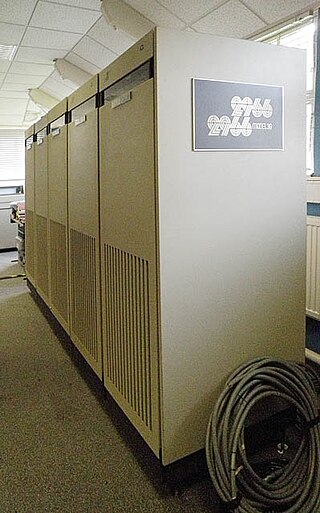Related Research Articles

A mainframe computer, informally called a mainframe or big iron, is a computer used primarily by large organizations for critical applications like bulk data processing for tasks such as censuses, industry and consumer statistics, enterprise resource planning, and large-scale transaction processing. A mainframe computer is large but not as large as a supercomputer and has more processing power than some other classes of computers, such as minicomputers, servers, workstations, and personal computers. Most large-scale computer-system architectures were established in the 1960s, but they continue to evolve. Mainframe computers are often used as servers.

An operating system (OS) is system software that manages computer hardware and software resources, and provides common services for computer programs.
Computerized batch processing is a method of running software programs called jobs in batches automatically. While users are required to submit the jobs, no other interaction by the user is required to process the batch. Batches may automatically be run at scheduled times as well as being run contingent on the availability of computer resources.
VME is a mainframe operating system developed by the UK company International Computers Limited. Originally developed in the 1970s to drive ICL's then new 2900 Series mainframes, the operating system is now known as OpenVME incorporating a Unix subsystem, and runs on ICL Series 39 and Trimetra mainframe computers, as well as industry-standard x64 servers.
In computer architecture, 64-bit integers, memory addresses, or other data units are those that are 64 bits wide. Also, 64-bit central processing units (CPU) and arithmetic logic units (ALU) are those that are based on processor registers, address buses, or data buses of that size. A computer that uses such a processor is a 64-bit computer.

The IBM Series/1 is a 16-bit minicomputer, introduced in 1976, that in many respects competed with other minicomputers of the time, such as the PDP-11 from Digital Equipment Corporation and similar offerings from Data General and HP. The Series/1 was typically used to control and operate external electro-mechanical components while also allowing for primitive data storage and handling.
This article presents a timeline of events in the history of computer operating systems from 1951 to the current day. For a narrative explaining the overall developments, see the History of operating systems.

International Computers Limited (ICL) was a British computer hardware, computer software and computer services company that operated from 1968 until 2002. It was formed through a merger of International Computers and Tabulators (ICT), English Electric Computers (EEC) and Elliott Automation in 1968. The company's most successful product line was the ICL 2900 Series range of mainframe computers.
Edinburgh IMP is a development of Atlas Autocode, initially developed around 1966-1969 at the University of Edinburgh, Scotland. It is a general-purpose programming language which was used heavily for systems programming.
The Content Addressable File Store (CAFS) was a hardware device developed by International Computers Limited (ICL) that provided a disk storage with built-in search capability. The motivation for the device was the discrepancy between the high speed at which a disk could deliver data, and the much lower speed at which a general-purpose processor could filter the data looking for records that matched a search condition.
Direct Machine Environment, abbreviated DME, was a mainframe environment for the ICL 2900 Series of computing systems from International Computers Limited that was developed in the 1970s. DME was more-or-less an ICL 1900 order code processor in microcode, which permitted the ICL 1900 series executive, operating systems and program libraries to operate on the ICL 2900 series.
Remote job entry, or Remote Batch, is the procedure for sending requests for non-interactive data processing tasks (jobs) to mainframe computers from remote workstations, and by extension the process of receiving the output from such jobs at a remote workstation.

The ICL 2900 Series was a range of mainframe computer systems announced by the British manufacturer International Computers Limited on 9 October 1974. The company had started development under the name "New Range" immediately on its formation in 1968. The range was not designed to be compatible with any previous machines produced by the company, nor for compatibility with any competitor's machines: rather, it was conceived as a synthetic option, combining the best ideas available from a variety of sources.

The Manchester computers were an innovative series of stored-program electronic computers developed during the 30-year period between 1947 and 1977 by a small team at the University of Manchester, under the leadership of Tom Kilburn. They included the world's first stored-program computer, the world's first transistorised computer, and what was the world's fastest computer at the time of its inauguration in 1962.
JEAN was a dialect of the JOSS programming language developed for and used on ICT 1900 series computers in the late 1960s and early 1970s; it was implemented under the MINIMOP operating system. It was used at universities including the University of Southampton. The name was an acronym derived from "JOSS Extended and Adapted for Nineteen-hundred". It was operated interactively from a Teletype terminal, as opposed to using batch processing.
MINIMOP was an operating system which ran on the International Computers Limited (ICL) 1900 series of computers. MINIMOP provided an on-line, time-sharing environment, and typically ran alongside George 2 running batch jobs. MINIMOP was named to reflect its role as an alternative to the MOP facilities of George 3, which required a more powerful machine.
ICT 1900 was a family of mainframe computers released by International Computers and Tabulators (ICT) and later International Computers Limited (ICL) during the 1960s and 1970s. The 1900 series was notable for being one of the few non-American competitors to the IBM System/360, enjoying significant success in the European and British Commonwealth markets.

John Kenneth Iliffe was a British computer designer who worked on the design and evaluation of computers that supported fine-grained memory protection and object management. He implemented, evaluated and refined such designs in the Rice Institute Computer, R1 (1958–61) and the ICL Basic Language Machine (1963–68). A key feature in the architectures of both machines was control by the hardware of the formation and use of memory references so that the memory could be seen as a collection of data objects of defined sizes whose integrity is protected from the consequences of errors in address calculation, such as overrunning memory pointers.
References
- ↑ Whitfield, H.; Wight, A. S. (1 January 1973). "EMAS—The Edinburgh Multi-Access System". The Computer Journal. 16 (4): 331–346. doi: 10.1093/comjnl/16.4.331 .
- ↑ "Archived copy". Archived from the original on 16 December 2004. Retrieved 9 October 2004.
{{cite web}}: CS1 maint: archived copy as title (link) - ↑ Stephens, P. D. (1980). "The evolution of the operating system EMAS 2900". Software: Practice and Experience. 10 (12): 993–1008. doi:10.1002/spe.4380101206. S2CID 31830708.
- ↑ Rees, D. J. (1982). "The kernel of the EMAS 2900 operating system". Software: Practice and Experience. 12 (7): 655–667. doi:10.1002/spe.4380120707. S2CID 22177787.
- ↑ "Index of /archive/os/emas/emas2/subsystem/doc/loader". history.dcs.ed.ac.uk.
- ↑ Shelness, N. H. (1974). "The Edinburgh Multi-Access System scheduling and allocation procedures in the resident supervisor". Operating Systems. Lecture Notes in Computer Science. Vol. 16. pp. 293–310. doi:10.1007/BFb0029366. ISBN 978-3-540-06849-5.
- ↑ Rees, D. J. (1 January 1975). "The EMAS Director". The Computer Journal. 18 (2): 122–130. doi: 10.1093/comjnl/18.2.122 .
- ↑ Millard, G. E.; Rees, D. J.; Whitfield, H. (1 January 1975). "The standard EMAS subsystem". The Computer Journal. 18 (3): 213–219. doi: 10.1093/comjnl/18.3.213 .
- ↑ Wight, A. S. (1 January 1975). "The EMAS Archiving Program". The Computer Journal. 18 (2): 131–134. doi: 10.1093/comjnl/18.2.131 .
- ↑ Forsyth, C. H. (2011). "More Taste: Less Greed?". history.dcs.ed.ac.uk. Department of Computer Science University of York.
- ↑ "Index of /archive/os/emas". history.dcs.ed.ac.uk.